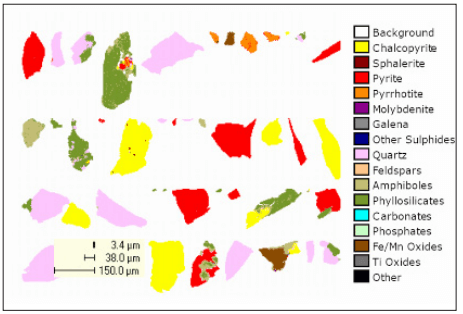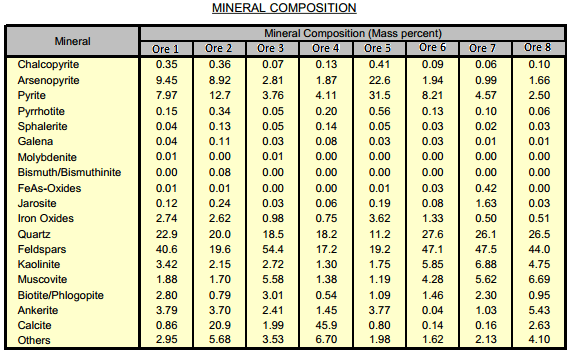As case study for the processing of an ore with a refractory component of visible and invisible Gold associated in and with Arsenopyrite had a gold content in the feed ranged from about 1.0 g/tonne to about 8.7 g/tonne depending on lithology. There was some difficulty in measuring the feed gold content due to the presence of coarse gold in the composites. The silver content ranged between about 3 and 35 g/tonne. This particular deposit has a heavy sulphide fraction as there were elevated levels of copper, sulphur, iron and arsenic, indicating the presence of copper sulphides, pyrite and arsenopyrite, which were all confirmed by mineralogy.

The mineral content and fragmentation characteristics of the lithology composites were generated by carrying out Particle Mineral Analysis
(PMA) on a sized feed sample using QEMSCAN. The results of these analyses are summarized below and can best be described as follows:
- The total sulphide mineral content, in the lithology composites, accounted for between 0.6 and 55 percent of the sample mass. The majority of sulphide minerals present were pyrite, arsenopyrite, pyrrhotite and chalcopyrite. On average, about 61 percent of the sulphide minerals were present as pyrite, while about 35 percent was present as arsenopyrite.
- Arsenic was essentially only associated with arsenopyrite, with the exception of Ore 7, which had about 28 percent associated with iron-arsenic oxides. This may be difficult to recover using conventional flotation conditions.
- Copper sulphide content within the lithology composites ranged between 0.06 and 0.41 percent. The copper sulphide minerals were
dominated by chalcopyrite. This is generally a low sodium cyanide consumer during cyanide leach tests. - The dominant non-sulphide gangue minerals present were quartz, feldspars and calcite.



